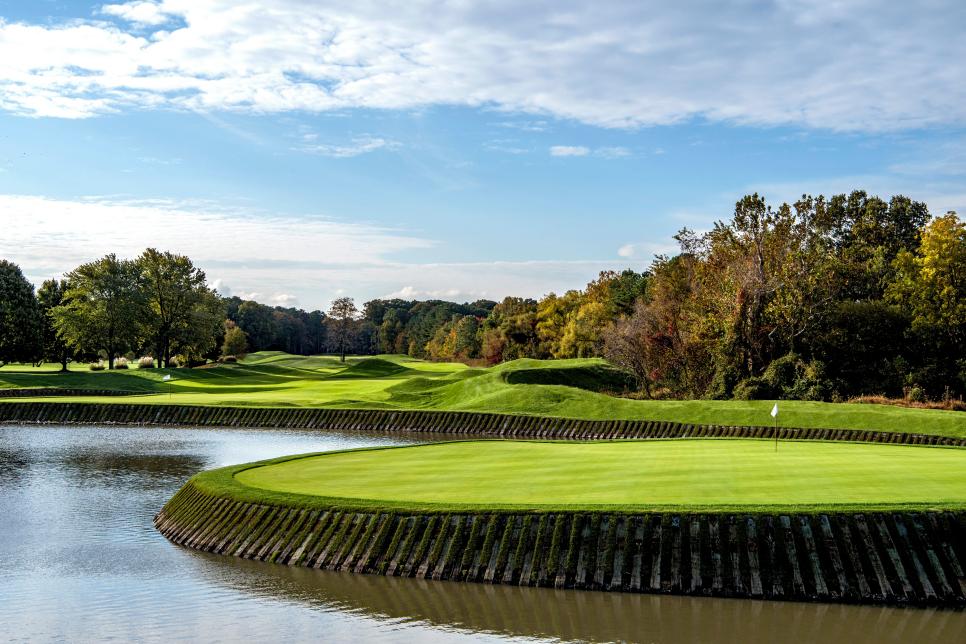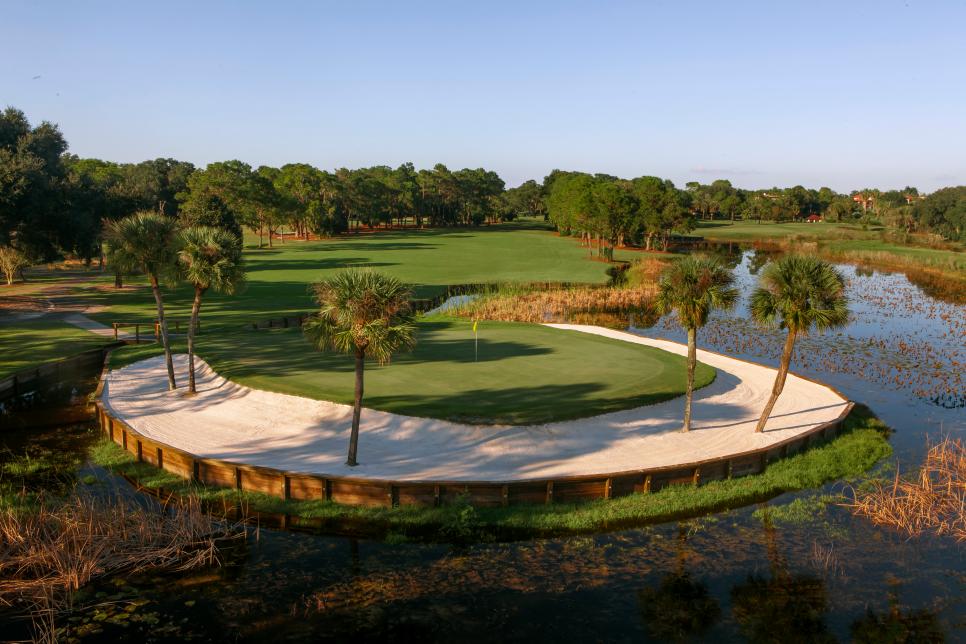Players 2023
Move over TPC Sawgrass. Here are golf’s best island greens

Contrary to what golf fans might think, Pete Dye did not invent the island green. Actually, it wasn’t even his idea (originally) to incorporate the peninsula concept at TPC Sawgrass’ 17th hole. The suggestion came from Dye’s wife and design partner, Alice—and since the Players Championship venue opened in 1980, the one-shotter has become one of golf’s most well-known holes.
The island green isn’t a revered “template” like the famous Redan, Biarritz or other designs brought over from iconic Scottish links designs. It was, however, likely first conceived by a Scotsman, George Low, the longtime club pro at Baltusrol Golf Club, who supposedly had the idea ahead of the 1904 U.S. Amateur to create an island green on a par 4 on the club’s now-defunct Old course (on the site of the current-day 16th hole of the Lower). Not surprisingly, the hole confounded competitors, and after the 1915 U.S. Open, and it was eventually abandoned.
Thankfully for us, initial complaints of TPC Sawgrass and the 17th hole have not only led to an acceptance but also hundreds of iterations of the concept at courses around the world. There are dozens of deserving entries left off this list, so we’ve tried to keep this as a collection of both lesser-known island greens and also important island greens in golf history.
Ponte Vedra (Fla.) Inn & Club (Ocean), ninth hole

LC Lambrecht/Courtesy of the club
TPC Sawgrass’ 17th hole is not the only island green in Ponte Vedra Beach, Fla., and it also wasn't the first. Some 60 years earlier, Herbert Strong’s Ocean course at the Ponte Vedra Inn & Club opened with the island-green par-3 ninth hole. After TPC Sawgrass was constructed, Alice Dye admitted she was influenced by Strong's creation here in recommending the island green to her husband, as Alice had played the Ocean course a number of times in competitions.
PGA West (Stadium), La Quinta, Calif., 17th hole

Just like TPC Sawgrass when it first opened, PGA West received a healthy amount of criticism from tour pros—so much that the PGA Tour event in Palm Springs moved from Dye’s creation in La Quinta for some time. Now it’s back at the Stadium course, and also just like TPC Sawgrass, the 17th hole at PGA West’s Stadium course has developed a reputation for (fairly) testing the pros down the stretch.

The Links at Perry Cabin, St. Andrews, Md., 17th hole

Joann Dost
Before Dye's tragic decline due to dementia, the final design he oversaw from start to finish was the overhaul of an existing course to build his own layout at The Links at Perry Cabin. Fittingly, some of Dye’s most famous holes were incorporated into this routing, and the 17th hole is a near replica of his Sawgrass creation.
The Creek, Locust Valley, N.Y., 11th hole (opening photo)
C.B. Macdonald is widely considered the father of American golf course architecture, bringing many classic design templates from the best courses of the British Isles to the States. In designing the 11th hole at The Creek, not only did he incorporate a classic Biarritz-style putting surface as he often did, but he and partner Seth Raynor built the green on an island—creating perhaps one of the most underrated putting complexes in the "MacRaynor" portfolio.
Coeur d’Alene (Idaho) Resort G. Cse., 14th hole

Quicksilver Studios
One of the more unique experiences in golf can be found in Coeur d’Alene, where golfers hit their tee shot to a large island-green target at the 14th, which is moved back and forth remotely by the resort each day. Then golfers hop aboard a ferry, which transports them to putt out. The hole is located right out back the clubhouse, creating a fun scene at this course, designed by Scott Miller, a former Jack Nicklaus associate.
Cherry Hills Country Club, Cherry Hills Village, Colo., 17th hole

Evan Schiller
The island green concept is incorporated into a par 5 at Cherry Hills, the iconic William Flynn and Howard Toomey design perhaps most known for its opening hole, driven by Arnold Palmer in the final round of the 1960 U.S. Open.
East Lake Golf Club, Atlanta, 15th hole

Chris Condon/PGA Tour/Getty Images
If Baltusrol was the site of the first island green in the U.S., East Lake might've had the second. Before Donald Ross and Bobby Jones redesigned the course in the 1910s, Tom Bendelow (architect of Medinah No. 3 among others) incorporated an island green into his design of the club's old par-5 seventh hole. When Ross rerouted the course, he decided to make the green a target for a par 3 (on the old front nine, which is now the back nine today for the Tour Championship). Given that Baltusrol's hole no longer exists, this very well may be the oldest island green still in use today.
Eagle Eye G. Cse, Bath, Mich., 17th hole

Dave Lee Photography
Longtime Dye associate Chris Lutzke called up his mentor when designing Eagle Eye to seek Dye’s opinion on his new creation. Pete and Alice thought the island-green concept could work, so much so that the exact dimensions were lasered and built exactly to the specs of TPC Sawgrass as it existed when the course opened in 2003—a proper touch at this layout, one of the top-10 public courses in golf-rich Michigan.

Las Vegas Paiute Golf Resort (Wolf), 15th hole

Dye utilized the island template at the Wolf, one of three layouts of his at this resort located about 30 minutes off the Las Vegas Strip.

Stone Harbor G.C., Cape May Court House, N.J., seventh hole

Courtesy of the club
Originally designed by Desmond Muirhead, described by Golf Digest as one of the most innovative designers of our time, this hole has been transformed over the years. Intimidating, teeth-shaped bunkers once flanked either side of a football-shape green, but redesigns over the years have enlarged the green and made this target slightly less daunting, though it now plays longer than it once did.
Mission Hills Country Club (Tournament), Rancho Mirage, Calif., 18th hole

David Cannon/Getty Images
Muirhead also designed the Tournament Course at Mission Hills Country Club, which has hosted the first women’s major of the year, now the Chevron Championship, since the event started in 1972. The closing hole is a par 5 with an iconic approach to an island green, which now features grandstands behind the green, taking away a bit of the intimidation of hitting the approach to this par 5 with the tournament on the line. This year's Chevron will be the last time it's played at Mission Hills, with the tournament moving to a still-to-be-named Houston-area course in 2023.
The Club at Olde Cypress, Naples, Fla., 12th hole

Courtesy of the club
One of Pete’s sons, P.B., has developed his own reputation in the design world. And he describes how the 12th hole at Olde Cypress came to be:
“At the time the developer needed a solution for the drainage and pumping from the surrounding agricultural fields,” P.B. told us. “So, I said, ‘Why don’t we build an island green.’ We moved a tremendous amount of earth up and down, not side to side, on that hole. Looking out at all those rock boulders from the tee box, it’s a sight to see. It’s one of the only holes of its kind that I know of.”
Man O’War, Myrtle Beach, 15th hole

Golf Tourism Solutions
If you’re a fan of island greens, book Man O’War for your next Myrtle trip. Back-to-back holes offer island greens: The 14th is a short-range par 4 and the above is a short par 3 (about 125 yards) playing to a 48-yard wide, 65-yard deep green. The facility boasts itself as the only course with back-to-back island greens in America. Plus, it also has an “island hole” with water surrounding the fairway and green.

Mission Inn Resort & Club (El Campeón), Howey-in-the-hills, Fla., 16th hole

Russell Kirk
One of Florida’s oldest courses, El Campeón opened in 1917 and has kept its reputation as one of the tougher courses in state. Though not long, the par-4 16th does demand precision on your tee shot and approach with water surrounding the fairway and fronting the green. A moat of bunkers flanks the green on the back side, saving golfers with long approaches from a wet second shot.

Secession Golf Club, Beaufort, S.C., 17th hole

Jon Cavalier
Though Bruce Devlin ended up getting the job at Secession, Pete and P.B. Dye had originally done a routing for the club before a dispute ended their relationship. The Dyes’ influence is certainly still on property, and the par-3 17th hole is almost straight out of their playbook, with an island green surrounded by bulkheads. Several holes at the ultra-private Secession actually sit on an island, and the 17th hole can be a true test, particularly when the winds pick up.
Punta Mita Golf Club (Pacifico), Mexico, Hole 3B

Photo by Jim Mandeville/The Nicklaus Companies
One of the most interesting greensites in the world is the optional green at Pacifico's par-3 third hole—with a green built out of an island outcropping 180 yards from the Pacific shore. The hole is weather-permitting: The green’s accessible only by amphibious vehicle, and the surf is too choppy at times to go back and forth—so there is another, landlocked hole to play.
Apple Tree Resort, Yakima, Wash., 17th hole

Sitting on a 100-plus-year apple orchard about two hours from Seattle, Apple Tree provides an idyllic setting open to the public. The island-green 17th hole is pretty inviting, too—with nine sets of tee boxes and a putting surface measuring nearly 10,000 square feet and, yes, shaped like an apple.



